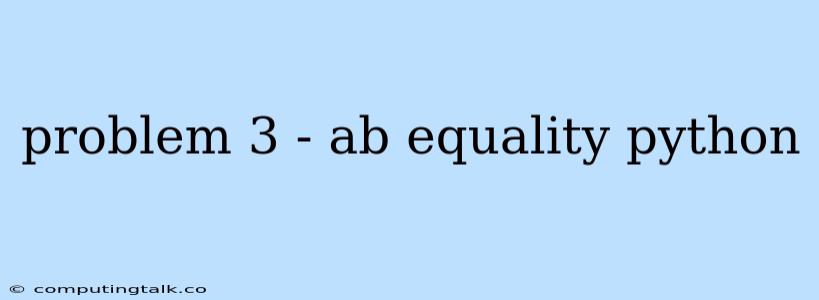In the realm of Python programming, encountering issues is an inevitable part of the journey. Among these challenges, one that often arises is the "problem 3 - ab equality" scenario. This situation typically occurs when you're working with variables, and you need to determine whether two variables, 'a' and 'b', are equal to each other.
Let's delve into the common causes of this "problem 3 - ab equality" and explore effective solutions to ensure your Python code functions flawlessly.
Understanding the Problem
The fundamental question at the heart of "problem 3 - ab equality" is: how do you accurately compare the values of two variables, 'a' and 'b', in Python? This seemingly simple task can become intricate depending on the data types involved and the specific comparison you're aiming for.
Data Types and Comparisons
Python supports various data types, including integers, floats, strings, lists, and dictionaries. The way you compare these data types can impact the outcome of your 'ab equality' check.
- Integer and Float Comparisons: For numeric values, the
==operator checks for strict equality. For example:
a = 5
b = 5.0
print(a == b) # Output: True
In this case, even though 'a' is an integer and 'b' is a float, the equality check returns True because their numerical values are the same.
- String Comparisons: When dealing with strings, the
==operator compares character by character. If the sequence of characters in both strings is identical, the comparison returnsTrue. For instance:
a = "Hello"
b = "Hello"
print(a == b) # Output: True
However, consider this:
a = "Hello"
b = "hello"
print(a == b) # Output: False
Here, despite the similar spelling, the strings differ in case sensitivity. Python treats "Hello" and "hello" as distinct values.
- List and Dictionary Comparisons: For lists and dictionaries, the
==operator checks for equality based on the contents of the objects. If the elements within the lists or the key-value pairs within the dictionaries are identical, the comparison returnsTrue.
a = [1, 2, 3]
b = [1, 2, 3]
print(a == b) # Output: True
a = {"name": "Alice", "age": 30}
b = {"name": "Alice", "age": 30}
print(a == b) # Output: True
However, the order of elements in lists and dictionaries can affect the result. If the order of elements is not consistent, the comparison will return False.
Common Causes of "Problem 3 - ab Equality"
- Data Type Mismatch: Attempting to compare variables of different data types can lead to unexpected outcomes.
- Case Sensitivity: When comparing strings, case sensitivity can cause discrepancies.
- Order of Elements: In the case of lists and dictionaries, the order of elements can influence the comparison results.
- Object Identity vs. Value Equality: The
isoperator checks for object identity, while the==operator checks for value equality. If you want to ensure two variables refer to the same object in memory, useis.
Solutions for "Problem 3 - ab Equality"
- Explicit Type Conversion: If you need to compare variables of different data types, consider converting them to a common type before using
==. - Case-Insensitive Comparisons: For strings, you can use the
lower()orupper()methods to convert both strings to a consistent case before comparison. - Iterate through Lists and Dictionaries: When working with lists or dictionaries, you may need to iterate through their contents to verify the equality of individual elements or key-value pairs.
- Use
isOperator: If you require object identity comparison, use theisoperator instead of==.
Examples
Let's look at some examples to illustrate the concepts discussed.
Example 1: Explicit Type Conversion
a = 5
b = "5"
print(a == b) # Output: False
print(a == int(b)) # Output: True
In this example, we convert the string 'b' to an integer using the int() function before comparing it to the integer 'a'. This ensures a meaningful comparison.
Example 2: Case-Insensitive Comparisons
a = "Hello"
b = "hello"
print(a == b) # Output: False
print(a.lower() == b.lower()) # Output: True
We use the lower() method to convert both strings to lowercase before comparing them. This eliminates case sensitivity and allows for a valid comparison.
Example 3: Iterating through Lists
a = [1, 2, 3]
b = [1, 2, 4]
are_equal = True
for i in range(len(a)):
if a[i] != b[i]:
are_equal = False
break
print(are_equal) # Output: False
In this example, we iterate through the elements of both lists to compare them individually. If any corresponding elements differ, the flag are_equal is set to False, indicating inequality.
Conclusion
Successfully addressing the "problem 3 - ab equality" in Python requires understanding the intricacies of data types, comparison operators, and potential pitfalls. By applying the concepts discussed, including explicit type conversions, case-insensitive comparisons, and iterating through lists and dictionaries, you can confidently compare variables in your code and achieve accurate results. Remember that the choice of comparison operator depends on the specific requirement of your program.
